Goal 3 - Mendel and Genetics
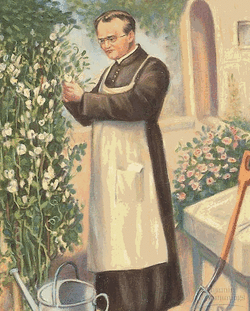
Mendel’s Experiments
(Pages 253-top 257, Pages 257-258 Phenotypes and Genotypes, 260-261 Punnett Square (monohybrid crosses only), and Pages 261-262 Probability)
Why Mendel Succeeded
(Pages 253-top 257, Pages 257-258 Phenotypes and Genotypes, 260-261 Punnett Square (monohybrid crosses only), and Pages 261-262 Probability)
Why Mendel Succeeded
- It was not until the mid-nineteenth century that Gregor Mendel, an Austrian monk, carried out important studies of heredity--the passing on of characteristics from parents to offspring.
- Characteristics that are inherited are called traits.
- Mendel was the first person to succeed in predicting how traits are transferred from one generation to the next.
- A complete explanation requires the careful study of genetics--the branch of biology that studies heredity.
Mendel's Experiments
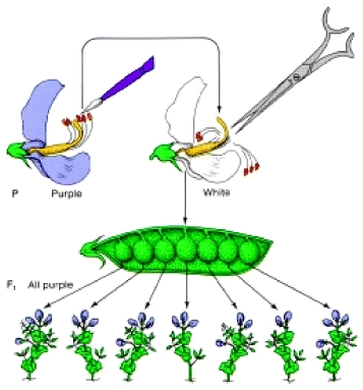
Mendell Chose his subject carefully
Mendel chose to use the garden pea in his experiments for several reasons.
The transfer of pollen grains from a male reproductive organ to a female reproductive organ in a plant is called pollination.
Mendel was a careful researcher
Mendel chose to use the garden pea in his experiments for several reasons.
- Garden pea plants reproduce sexually, which means that they produce male and female sex cells, called gametes.
- The male gamete forms in the pollen grain, which is produced in the male reproductive organ.
- The female gamete forms in the female reproductive organ.
- In a process called fertilization, the male gamete unites with the female gamete.
- The resulting fertilized cell, called a zygote, then develops into a seed.
The transfer of pollen grains from a male reproductive organ to a female reproductive organ in a plant is called pollination.
- When he wanted to breed, or cross, one plant with another, Mendel opened the petals of a flower and removed the male organs.
- He then dusted the female organ with pollen from the plant he wished to cross it with.
- This process is called cross-pollination.
- By using this technique, Mendel could be sure of the parents in his cross.
Mendel was a careful researcher
- He studied only one trait at a time to control variables, and he analyzed his data mathematically.
- The tall pea plants he worked with were from populations of plants that had been tall for many generations and had always produced tall offspring.
- Such plants are said to be true breeding for tallness.
- Likewise, the short plants he worked with were true breeding for shortness.
Experiment 1
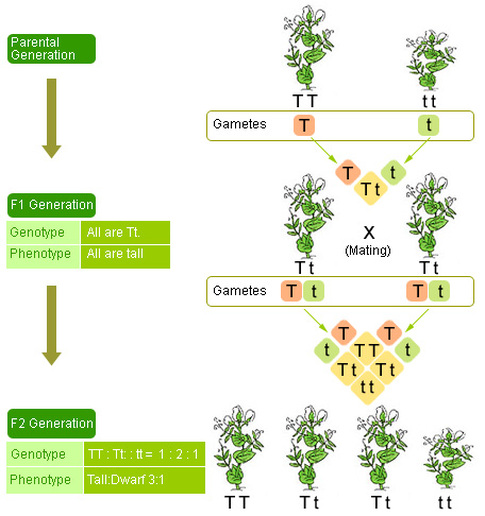
Mendel’s Monohybrid Crosses
The first generation
The second generation
Mendel allowed the tall plants in this first generation to self-pollinate.
After the seeds formed, he planted them and counted more than 1000 plants in this second generation.
- A hybrid is the offspring of parents that have different forms of a trait, such as tall and short height.
- Mendel’s first experiments are called monohybrid crosses because mono means “one” and the two parent plants differed from each other by a single trait —height.
The first generation
- Mendel selected a six-foot-tall pea plant that came from a population of pea plants, all of which were over six feet tall.
- He cross-pollinated this tall pea plant with pollen from a short pea plant.
- All of the offspring grew to be as tall as the taller parent.
The second generation
Mendel allowed the tall plants in this first generation to self-pollinate.
After the seeds formed, he planted them and counted more than 1000 plants in this second generation.
- Three-fourths
of the plants were as tall as the tall plants in the parent and
first generations.
- One-fourth of the offspring were as short as the short plants in the parent generation.
- In the
second generation, tall and short plants occurred in a ratio
of about three tall plants to one short plant.
- The original
parents, the true-breeding plants, are known as the P1 generation.
- The offspring
of the parent plants are known as the F1 generation.
- When
you cross two F1 plants with each other, their
offspring are the F2 generation.
- In every case, he found that one trait of a pair seemed to disappear in the F1 generation, only to reappear unchanged in one-fourth of the F2 plants.
Mendels Laws of Genetics
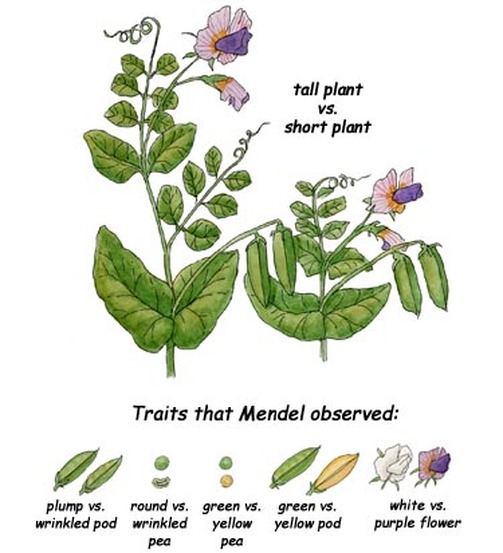
The Rule of Unit Factor
The Rule of Dominance
The Law of Segregation
Law of Independent Assortment
- Mendel concluded that each organism has two factors that control each of its traits.
- We now know that these factors are genes and that they are located on chromosomes.
- Genes exist in alternative forms. We call these different gene forms alleles.
- An organism’s two alleles are located on different copies of a chromosome—one inherited from the female parent and one from the male parent.
The Rule of Dominance
- Mendel called the observed trait dominant and the trait that disappeared recessive.
- Mendel concluded that the allele for tall plants is dominant to the allele for short plants.
- When recording the results of crosses, it is customary to use the same letter for different alleles of the same gene.
- An uppercase letter is used for the dominant allele and a lowercase letter for the recessive allele.
- The dominant allele is always written first.
The Law of Segregation
- The law of segregation states that every individual has two alleles of each gene and when gametes are produced, each gamete receives one of these alleles.
- During fertilization, these gametes randomly pair to produce four combinations of alleles.
Law of Independent Assortment
- Mendel’s second law states that genes for different traits —for example, seed shape and seed color—are inherited independently of each other.
- This conclusion is known as the law of independent assortment.
Phenotypes, Genotypes and Punnet Squares
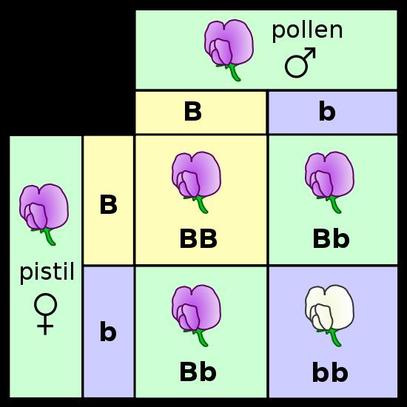
Phenotypes and Genotypes
Punnett Squares
Monohybrid Crosses
Probability
- Two organisms can look alike but have different underlying allele combinations.
- The way an organism looks and behaves is called its phenotype.
- The allele combination an organism contains is known as its genotype.
- An organism’s genotype can’t always be known by its phenotype.
- An organism is homozygous for a trait if its two alleles for the trait are the same.
- The true-breeding tall plant that had two alleles for tallness (TT)would be homozygous for the trait of height.
- An organism is heterozygous for a trait if its two alleles for the trait differ from each other.
- Therefore, the tall plant that had one allele for tallness and one allele for shortness (Tt) is heterozygous for the trait of height.
Punnett Squares
- In 1905, Reginald Punnett, an English biologist, devised a shorthand way of finding the expected proportions of possible genotypes in the offspring of a cross.
- This method is called a Punnett square.
- If you know the genotypes of the parents, you can use a Punnett square to predict the possible genotypes of their offspring.
Monohybrid Crosses
- A Punnett square for this cross is two boxes tall and two boxes wide because each parent can produce two kinds of gametes for this trait.
- The two kinds of gametes from one parent are listed on top of the square, and the two kinds of gametes from the other parent are listed on the left side.
- It doesn’t matter which set of gametes is on top and which is on the side.
- Each box is filled in with the gametes above and to the left side of that box. You can see that each box then contains two alleles—one possible genotype.
- After the genotypes have been determined, you can determine the phenotypes.
Probability
- In reality you don’t get the exact ratio of results shown in the square.
- That’s because, in some ways, genetics is like flipping a coin —it follows the rules of chance.
- The probability or chance that an event will occur can be determined by dividing the number of desired outcomes by the total number of possible outcomes.
- A Punnett square can be used to determine the probability of getting a pea plant that produces round seeds when two plants that are heterozygous (Rr) are crossed.
- The Punnett square shows three plants with round seeds out of four total plants, so the probability is 3/4 (or 75%).
- It is important to remember that the results predicted by probability are more likely to be seen when there is a large number of offspring.
